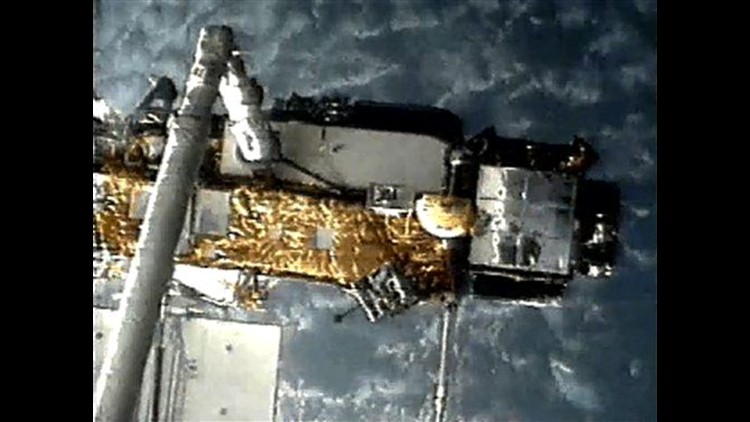WASHINGTON (AP) — It's as big as a bus and weighs 6 tons, but officials probably will never be able to pinpoint exactly where a massive NASA satellite plummeted to Earth.
NASA space junk scientists believe that all — or nearly all — of the parts of their 20-year-old dead satellite safely plunged into the Pacific Ocean, likely missing land. But if their estimates are off, by only five minutes or so, fiery pieces could have fallen on parts of northwestern North America.
No injuries or damage have been reported on land, which NASA officials said was a good indication the satellite went into the ocean.
That doesn't necessarily mean it all fell into the sea. Some debris could have fallen over areas such as Portland, Ore.; Seattle; Calgary, Alberta; and Saskatoon, Saskatchewan, said Jonathan McDowell of the Harvard-Smithsonian Center for Astrophysics.
"Pieces are falling off of this flaming fire ball, and some of it has enough momentum to go hundreds of miles," he said.
Speculation was rampant on sites such as Twitter. There were no credible reports of debris on the ground, said Nick Johnson, NASA's chief scientist for orbital debris. But if the satellite fell even five minutes later than estimated, some of it could have hit land, he said.
"We don't know where the re-entry point exactly was. We don't exactly know where the debris field is," Johnson said.
NASA's earlier calculations had predicted that the former climate research satellite would fall over a 500-mile swath and could include land. Officials said the 35-foot satellite fell sometime between 11:23 p.m. EDT Friday and 1:09 a.m. EDT Saturday.
Much of the speculation focused on unconfirmed reports and even video of debris from the Upper Atmosphere Research Satellite over Alberta, Canada.
NASA spokesman Steve Cole said that was possible because the last track for the satellite included Canada, starting north of Seattle and then in a large arc north then south. From there, the track continued through the Atlantic south toward Africa, but it was unlikely the satellite got that far if it started falling over the Pacific.
Some 26 pieces of the satellite representing 1,200 pounds of heavy metal had been expected to rain down somewhere. The biggest surviving chunk should be no more than 300 pounds.
NASA urges anyone who thinks they've found satellite debris to call police. It's government property and illegal to keep it or try to sell it. The debris has no toxic contamination, but there could be sharp edges, NASA officials have said.
UARS is the biggest NASA spacecraft to crash back to Earth, uncontrolled, since the post-Apollo 75-ton Skylab space station and the more than 10-ton Pegasus 2 satellite, both in 1979.
Russia's 135-ton Mir space station slammed through the atmosphere in 2001, but it was a controlled dive into the Pacific.
Before UARS fell, no one had ever been hit by falling space junk and NASA expected that not to change.
NASA put the chances that somebody somewhere on Earth would get hurt at 1-in-3,200. But any one person's odds of being struck were estimated at 1-in-22 trillion, given there are 7 billion people on the planet.
The satellite ran out of fuel and died in 2005. UARS was built and launched before NASA and other nations started new programs that prevent this type of uncontrolled crashes of satellite.
___
Kennedy reported from Miami.
___
Online:
NASA: http://www.nasa.gov/mission_pages/uars/index.html
Copyright 2011 The Associated Press.
THIS IS AN UPDATE TO THE PREVIOUS STORY BELOW.
WASHINGTON (AP) — NASA's dead 6-ton satellite plunged to Earth early Saturday, but more than eight hours later, U.S. space officials didn't know just where it hit. They thought the fiery fall was largely over water and the debris probably hurt no one.
The agency did not give a more specific location in a midday update on its website, which also said officials were not aware of any reports of injuries or property damage. Most of the spacecraft was believed to have burned up.
The bus-sized satellite first penetrated Earth's atmosphere somewhere over the Pacific Ocean, according to NASA and the U.S. Air Force's Joint Space Operations Center. But that doesn't necessarily mean it all fell into the sea.
NASA's earlier calculations had predicted that the 20-year-old former climate research satellite would fall over a 500-mile swath and could include land.
Because the plummet began over the ocean and given the lack of any reports of people being hit, that "gives us a good feeling that no one was hurt," but officials didn't know for certain, NASA spokesman Steve Cole told The Associated Press.
The two government agencies said the 35-foot satellite fell sometime between 11:23 p.m. EDT Friday and 1:09 a.m. EDT Saturday, but with no precise time or location.
There was rampant speculation on the Internet and Twitter, much of it focusing on unconfirmed reports and even video of debris from the Upper Atmosphere Research Satellite over Alberta, Canada.
Jonathan McDowell of the Harvard-Smithsonian Center for Astrophysics said the spacecraft entered the atmosphere around 12:15 a.m. EDT over the coast of Washington. He said much of the debris likely fell over the Pacific Ocean, with some making it to Canada over northern Alberta and perhaps as far as the Hudson Bay.
"Pieces are falling off of this flaming fire ball, and some of it has enough momentum to go hundreds of miles," he said.
But McDowell said he'd be surprised if anyone was hurt by the debris because it appears to have fallen in such remote areas.
"I do think people saw lights in the sky and fireballs and may well be bits of UARS falling down," he said.
Cole said that was possible because the last track for the satellite included Canada, starting north of Seattle and then in a large arc north then south. From there, the track continued through the Atlantic south toward Africa, but it was unlikely the satellite got that far if it started falling over the Pacific.
Cole said NASA was hoping for more details from the Air Force, which was responsible for tracking debris.
But given where the satellite may have fallen, officials may never quite know precisely.
"Most space debris is in the ocean. It'll be hard to confirm," Cole said.
Some 26 pieces of the satellite representing 1,200 pounds of heavy metal had been expected to rain down somewhere. The biggest surviving chunk should be no more than 300 pounds.
UARS is the biggest NASA spacecraft to crash back to Earth, uncontrolled, since the post-Apollo 75-ton Skylab space station and the more than 10-ton Pegasus 2 satellite, both in 1979.
Russia's 135-ton Mir space station slammed through the atmosphere in 2001, but it was a controlled dive into the Pacific.
Before UARS fell, no one had ever been hit by falling space junk and NASA expected that not to change.
NASA put the chances that somebody somewhere on Earth would get hurt at 1-in-3,200. But any one person's odds of being struck were estimated at 1-in-22 trillion, given there are 7 billion people on the planet.
The satellite ran out of fuel and died in 2005. UARS was built and launched before NASA and other nations started new programs that prevent this type of uncontrolled crashes of satellite.
___
Associated Press Writer Kelli Kennedy contributed to this report from Miami.
___
Online:
NASA: http://www.nasa.gov/mission_pages/uars/index.html
Copyright 2011 The Associated Press.



